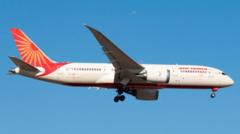The recent investigation into the Air India Flight 171 crash, which claimed 260 lives in June, has revealed alarming findings that deepen the mystery surrounding the incident. Shortly after takeoff, the Boeing 787 Dreamliner's fuel-control switches unexpectedly shifted to the "cut-off" position, leading to an immediate loss of engine power—a maneuver typically reserved for landing scenarios.
A critical piece of evidence is the cockpit voice recording, where one pilot questions his counterpart about the switch to "cut-off." The response indicates no one took that action, raising serious concerns about what occurred in the cockpit just before the plane lost thrust and crashed into a crowded neighborhood in Ahmedabad within 40 seconds of takeoff.
The preliminary 15-page report outlines that during the flight, the aircraft briefly climbed to 625 feet before losing all location data. The investigation is being led by Indian authorities, along with experts from Boeing, General Electric, and aviation regulators from the US and UK, who are dissecting the wreckage and recordings to uncover potential failures that contributed to the crash.
It is noteworthy that the fuel lever switches, which are designed to be nearly impossible to activate accidentally due to their locking mechanisms, have become a focal point of the investigation. Aviation experts assert that pulling both switches simultaneously would require an unlikely movement, putting into question whether it was a deliberate action by one of the pilots or perhaps a more complex malfunction.
Industry veterans, including Shawn Pruchnicki, an aviation safety expert at Ohio State University, speculate on the implications of the switches' operation: "Was it intentional or confusion? This does not seem likely given that neither pilot reported any abnormalities."
Concerns are also arising from a previous advisory from the US Federal Aviation Administration regarding disabling safety lock features in fuel control switches on certain Boeing models, including those utilized in the Dreamliner series. While this advisory was not associated with serious risk levels, the failure of Air India to comply with related inspections could be critical in discerning the cause of the tragic incident.
Moreover, experts are also considering whether external factors might have influenced the switches, such as electronic triggers from the aircraft's control unit. As they delve deeper, they highlight the need for clear identification of cockpit voices and thorough analysis of all communications leading up to the crash.
The report further indicated signs of a major systems failure, including the deployment of the Ram Air Turbine (RAT), an emergency power supply that activates when both engines lose power. Investigators are piecing together a timeline of events that left the pilots scrambling to regain thrust as the aircraft descended rapidly.
Ultimately, while the investigation is ongoing, the stream of technical confusion—surrounding cockpit decisions, aircraft control anomalies, and accountability—paints a complex picture of a catastrophic incident that demands thorough scrutiny moving forward.


















